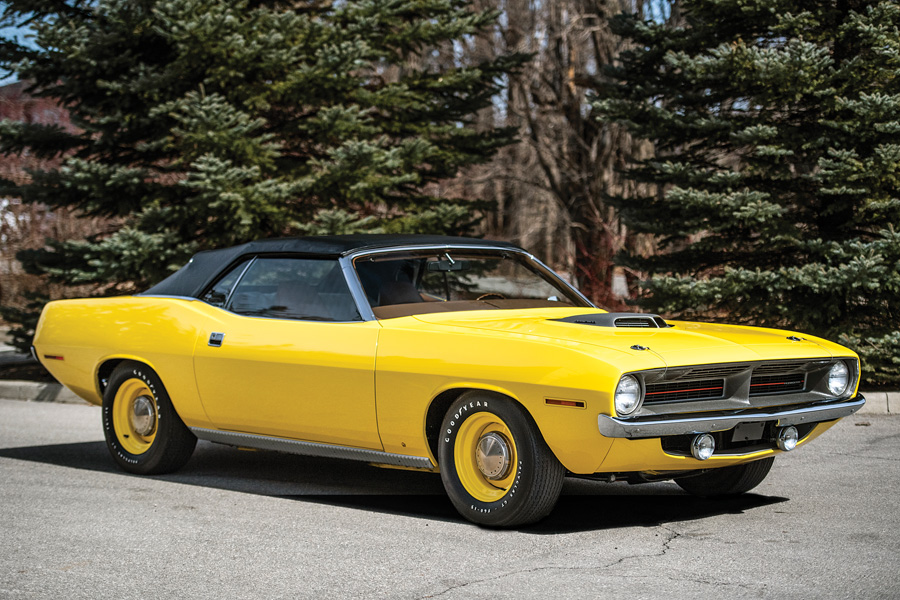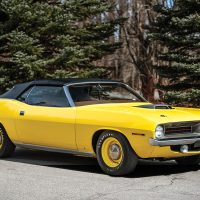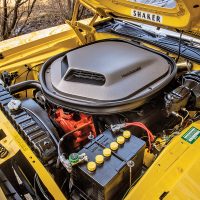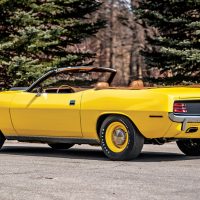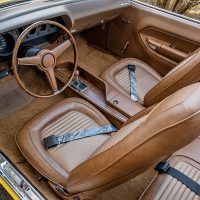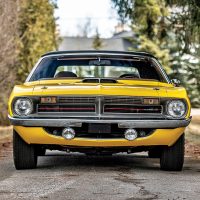SCM Analysis
Detailing
| Vehicle: | 1970 Plymouth Hemi ’Cuda Convertible |
| Years Produced: | 1970 |
| Number Produced: | 14 (or 18, depending on your source) |
| Original List Price: | $4,400 |
| SCM Valuation: | $2,475,000 |
| Tune Up Cost: | $1,000 |
| Chassis Number Location: | VIN plate on the driver’s side dash |
| Engine Number Location: | Passenger’s side of engine block, on machined pad above oil-pan rail and in front of the motor mount |
| Club Info: | Plymouth Barracuda/Cuda Owners Club |
| Website: | http://pbcoc.com |
| Alternatives: | 1970–71 Dodge Hemi Challenger, 1969–70 Ford Mustang Boss 429, 1970 Chevrolet Chevelle LS-6 |
| Investment Grade: | A |
This car, Lot F120, sold for $1,980,000, including buyer’s premium, at Mecum’s Indianapolis sale on May 17, 2019, at the Indiana State Fairgrounds.
The Hemi ’Cuda convertible seems to have found its way into our lexicon as the definition of the high-water mark of the raucous era of fuel-sucking, tire-smoking, ground-shaking American muscle cars of the early 1970s.
Sure, there are other rare muscle cars that can truly ring the auction bell, but very few do it with such overwhelming command of the auction block as a 1970 or 1971 Plymouth ’Cuda or Dodge Challenger Hemi-powered convertible. As soon as one rolls up on the block, out come the cell phones to capture the moment.
Expensive then. Super expensive now
Most examples of crazy-rare 1960s and 1970s American muscle were ultra expensive when they sold new. In 1970, a new performance Plymouth ’Cuda coupe with a 383-ci engine under the hood would set a buyer back about $3,200.
Jump into a convertible and the price would leap to $3,500 and up. Once you started to add options to the car — including putting huge horsepower under the hood — the price could really ratchet up.
That monster 426-ci Hemi under the hood came with a Godzilla-size price tag of $871.45 — just about a quarter of the base price. To put that into today’s dollars, it would be like paying an additional $10,000 for a $40,000 car.
Simply put, that made the 1970 ’Cuda convertible not only impractical to own — but also enormously expensive to purchase. With a price tag exceeding $4,300 — sparsely equipped, mind you — that places you in the same general ZIP code of a 1970 Ford Mustang Boss 429 or Shelby GT350 convertible. Given that, only 14 (some sources claim 18) buyers stepped up to the plate to purchase one.
Quality was not Job One
My very first car was a 1970 Dodge Challenger. I was the third owner. It was a 440 R/T with the sturdy 727 “Slap Stick” transmission on board.
I purchased it in 1978 for $500. While it was no cream puff, it was in pretty good shape with the original paint, zero rust, no accidents or dents and an interior that looked almost new once I had the seats reupholstered and tossed in some new carpet. In short, it was a pretty nice used car back in the day.
Since it was the first car I ever owned, I really didn’t know much about how a car should handle — and I certainly didn’t know diddly-squat about build quality.
But looking back on it, it was, well, a pretty crappy car. It shook and rattled. Slamming the door shut was like working out at the gym. It handled poorly and putting it hard into a turn was akin to being in a soapbox derby with an iron bathtub strapped to a skateboard.
The windows leaked and the trunk could occasionally be used as an aquarium after a heavy Florida downpour. All that said, I really loved that car.
My point is, Plymouth Hemi ’Cudas weren’t built all that well when they were semi-minty new cars. They had cheap vinyl interiors surrounded with molded plastic.
The chassis and suspensions were an afterthought in the convertible configuration. Add in a 425-horse Hemi under the hood, a lead foot, and a sticky hook-up out of the hole and you’ve got yourself a pretty good recipe for “Hmmm, why doesn’t the door shut right anymore?”
The poster child of American muscle
No matter how terrible the cars were when new, it makes no difference today — and that goes for just about any American muscle car. The allure is in the essence of what they represent to most buyers. Some buyers are in it solely as collectors and investors. Others pay up for what the cars represent to them personally.
However you define a car in your mind, investment-grade machines such as Hemi ’Cuda convertibles are now works of modern cultural art, worthy of any museum or private collection.
They’ve made the rare leap from an ordinary machine into an irreplaceable historical artifact. Those who wish to participate in the pursuit of the object will always set the values for these rare cars — if they have the money to play in that space.
No-frills build
Our subject 1970 Hemi ’Cuda convertible is one of only 14 ever built. Ratcheting it down further, it’s one of only nine built with an automatic transmission.
The car retains much of its original DNA. It comes with solid paperwork and most — if not all — of its original body panels. It no longer carries its original engine, but very few do.
In short, this is a great example of how the car presented when new, but it is in better condition now than when it first rolled off the Plymouth assembly line.
While this car is not a heavily optioned example, it’s still one of the 14 (or 18) ever built and sold. Where the options will make a difference is how it stacks up against other examples, via past or present sales. Of course, this is a very small number of comps.
A top-down view of the market
Values of the 1970 Hemi ’Cuda convertibles — and the even-more-rare 1971 cars — have been bouncing all over the block. To the best of my knowledge, private sales notwithstanding, the highest recent public sale price for a 1970 model chimed in at the 2016 Mecum Kissimmee sale for another Lemon Twist drop-top, which left the auction block at $2,675,000.
That car sold for a lot more than our subject car — but it was also better equipped — including the game-changing A833 4-speed, A34 Super Trak Pak, 4.10 Sure Grip rear end and A62 Rallye instrument cluster. Yes, having that third pedal means a lot in the small, expensive world of Hemi ’Cuda convertibles. Otherwise, the two cars are nearly identical comparables, given the non-original engines, same color and solid paperwork.
Going back a bit farther, another 1970 Hemi ’Cuda model changed hands at the 2015 Mecum Monterey sale for $2,250,000. That car was a highly optioned Executive Demo in black — but it also had an automatic transmission. This car was lavishly equipped with nearly every available option, which made it a rarity amongst rarities in the low-production world of Hemi ’Cudas.
The SCM Platinum Auction Database pegs the current median value of 1970 Hemi ’Cuda convertibles at $2,475,000.
As you can imagine, Hemi ’Cuda convertibles (or Dodge Challenger convertibles) rarely see the light of day, and the last 1970 model sold at public auction was in 2016, but that was for (arguably) a better example with far more desirable options.
Be that as it may, here we are three years down the road, and our subject car may have been the only opportunity to put one in your collection.
While the pedigree of our subject car is well documented, the lack of options and base trim level (if you dare call a Hemi ’Cuda convertible a base-level trim) likely hurt the overall value.
Of course, the biggest ding on the car was the automatic transmission. The tan interior is a one-of-one build — but likely less desirable than black.
Based on the limited past sales and current estimated valuations, the sale price of $1,980,000 seems to be fairly spot-on in today’s market. If another example happens to come out to play soon, we’ll find out if this one was well bought, well sold, or market correct. Only time will tell. For now, this is a market-correct result. ♦
(Introductory description courtesy of Mecum Auctions.)
